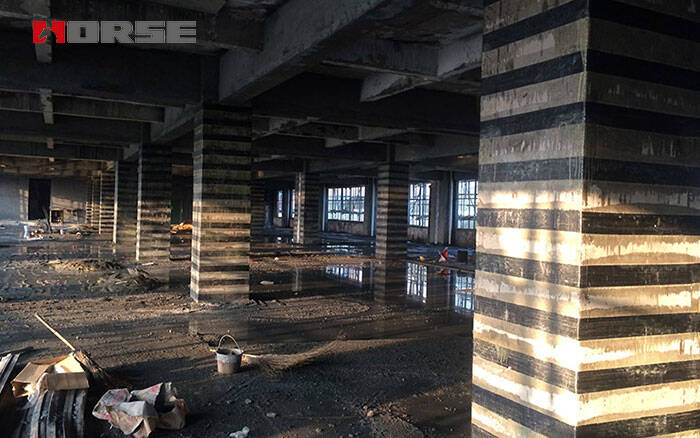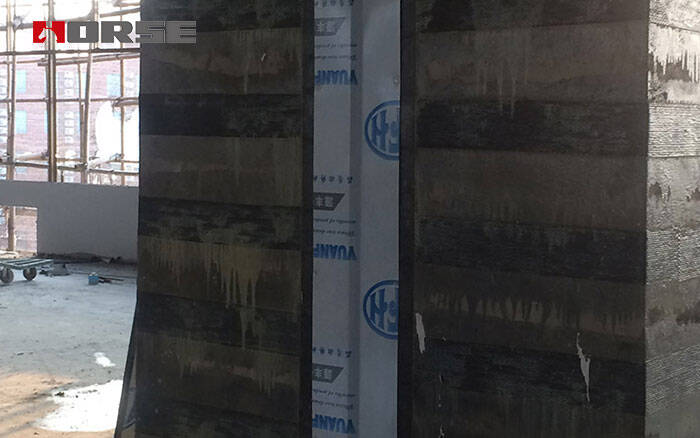Renforcement des colonnes
Enveloppe en fibre de carbone pour colonne et amélioration des performances sismiques
D'une part, l'enveloppement de PRFC peut augmenter dans une certaine mesure la résistance à la compression axiale du béton. D'autre part, l'effet de retenue transversale de l'enveloppement en fibre de carbone sur les poteaux peut également améliorer significativement la ductilité des poteaux sous charges horizontales et satisfaire aux exigences de ductilité du taux de compression axiale.

Dans une structure à ossature en béton armé à plusieurs étages, il a été constaté que la résistance du béton de neuf poteaux de l'ossature ne répondait pas aux exigences de conception lors de la réception des travaux, ce qui entraînait un taux de compression axiale excessif, ne permettant pas de respecter les exigences de ductilité requises par la valeur limite du taux de compression axiale. D'une part, l'enveloppement de PRFC peut augmenter la résistance à la compression axiale du béton dans une certaine mesure. D'autre part, l'effet de retenue transversale de l'enveloppement en fibres de carbone sur les poteaux peut également améliorer significativement la ductilité des poteaux sous charges horizontales et satisfaire aux exigences de ductilité du taux de compression axiale.
En calculant la capacité portante et la ductilité, trois poteaux présentant une résistance moindre sont enveloppés de trois couches d'enveloppement en PRFC sur toute leur hauteur. Pour les six autres poteaux, deux couches d'enveloppement en fibres de carbone seront enveloppées sur toute leur hauteur.
Analyse de la capacité portante et de la ductilité des armatures d'enveloppement en PRFC
Après l'enveloppement en fibres de carbone, la capacité de cisaillement et la ductilité des poteaux de l'ossature peuvent être considérablement améliorées.
La structure d'origine est constituée d'un poteau-cadre de 800 x 800 mm et d'une hauteur de 3,6 m. D'après les résultats de recherches pertinentes, la résistance au cisaillement de l'enveloppe en PRFC peut être améliorée par calcul.

Pour l'ensemble de l'enveloppe du projet, la formule est la suivante :


La résistance de conception du béton est de C40. Selon ce calcul, la résistance au cisaillement d'un poteau individuel devrait être de 1 312 kN. Pour les trois poteaux de résistance inférieure, la résistance minimale du béton est de 28,3 Mpa et la résistance au cisaillement est de 1 031 kN sans armature. L'enrobage de trois couches de PRFC augmente la capacité portante de 319 kN et la capacité portante totale est de 1 350 kN, ce qui est supérieur à la capacité portante de conception. Pour les six autres poteaux, la résistance minimale du béton est de 35 Mpa et la résistance au cisaillement est de 1 209 kN sans armature. L'enrobage de deux couches de fibre de carbone augmente la capacité portante de 246 kN et la capacité portante totale est de 1 455 kN, ce qui est supérieur à la capacité portante de conception.

Selon les résultats des tests, lorsque le taux de compression axiale est déterminé, le coefficient de ductilité des colonnes enrobées de PRFC augmente linéairement avec la résistance au cisaillement et le coefficient de flexion faible Vs/Vm. Lorsque le taux de compression axiale est de 0,48, la formule d'ajustement suivante est appliquée.
μ=-1.278+5.233Vs/VM
La formule ci-dessus montre que plus la résistance au cisaillement de la fibre de carbone est élevée, plus le rapport Vs/VM et le facteur de ductilité sont élevés.
De plus, selon la littérature, lorsque le coefficient de ductilité reste inchangé, le coefficient caractéristique de l'étrier présente la relation suivante avec le taux de compression axiale :

La formule ci-dessus montre que lorsque le taux de compression axiale augmente, le rapport de frette doit être augmenté de manière appropriée afin de maintenir le coefficient de ductilité inchangé.
Selon une estimation prudente, en supposant que le taux de compression axiale des poteaux augmente de 0,3 en raison de la diminution de la résistance du béton, l'augmentation correspondante du coefficient caractéristique de l'étrier est de 0,066, et le nouveau coefficient caractéristique de l'étrier en PRFC est de 0,097, ce qui satisfait pleinement aux exigences.
L'analyse ci-dessus montre que la quantité d'enveloppement en PRFC doit être déterminée en fonction de la capacité portante et de l'indice de ductilité lorsque les poteaux en béton armé sont renforcés avec un enveloppe en PRFC afin d'améliorer la résistance sismique.